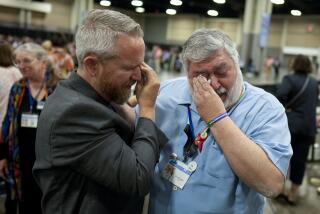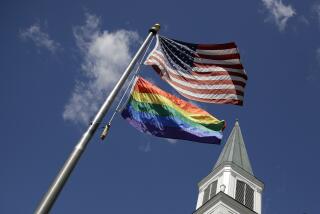Pick Chicago as Headquarters : Lutherans Overcome Obstacles to Merger
- Share via
SEATTLE — Representatives of three Lutheran denominations have ironed out the last major disputes that threatened a proposed merger, including one issue pertaining to the image of the new church body.
The 70-member Commission for a New Lutheran Church, which concluded its 10th and final conference Wednesday, had voted overwhelmingly last February to locate in Milwaukee, but it reversed itself this week, 41 to 25, to establish its headquarters in Chicago.
While regarded as more economical, the Milwaukee site was considered deficient in access by air.
‘Immigrant Mentality’
But Los Angeles Bishop Stanley E. Olsen of the Lutheran Church in America had echoed a number of objections to the choice of Milwaukee last February by saying that his fellow Lutherans were using an old “immigrant mentality.” “This is the way Lutherans purchased building sites back in the immigrant days--we found cheaper land on the side streets,” he said.
The Lutheran Church in America, the American Lutheran Church and the Assn. of Evangelical Lutheran Churches--meeting concurrently in separate cities--will debate the proposed constitution and bylaws between Aug. 26-29. If disagreements or amendments arise, negotiators will relay the information to other conventions by telephone.
If the groups approve the document, a convention will be held next spring in Columbus, Ohio, and the new 5.3-million-member Evangelical Lutheran Church in America, which would be the fifth largest U.S. Christian denomination, will be born on New Year’s Day, 1988.
‘We’ve Turned a Corner’
“Many of my concerns have been addressed and I really feel we’ve turned a corner,” said Presiding Bishop James R. Crumley of the Lutheran Church in America. “We’re still in a process (of working out details) and will be for some time, but I think now we can be committed not to just Lutheran unity but to the Evangelical Lutheran Church in America.”
In the final hours of the commission’s three-day conference, the panelists considered an old proposal to keep present denominational headquarters in New York, Minneapolis and St. Louis and decide later on the future headquarters. But straw votes failed to give solid backing to either that proposal or the commission’s previous choice of Milwaukee. An Assn. of Evangelical Lutheran Churches delegate then revived an old recommendation that the Chicago area be picked, and after about 15 minutes of debate it was selected, said American Lutheran Church spokesman Herb David.
(The Presbyterian Church U.S.A., which three years ago merged two denominations into a 3.1-million-member body, recently narrowed its search for a new headquarters to six cities: Charlotte, N.C.; Cincinnati; Fort Worth; Indianapolis; the Kansas City, Mo., area, and St. Louis. Unlike the Lutherans, the Presbyterians united first, then have worked on further details of their merger. The denomination is now operating from two older headquarters in New York and Atlanta.)
Sensitive Issue
The Lutheran delegates also worked out language addressing the sensitive issue of congregational authority. The Lutheran Church in America, which had raised the strongest objections, traditionally has had a more hierarchical leadership structure, while the American Lutheran Church gives local congregations greater decision-making power, particularly in the hiring and firing of pastors.
The new constitution contains language that officials say appears to take note of both concerns.
“I’m happy with the measure of authority that has been retained for the congregations,” said Bishop David W. Preus of Minneapolis, head of the American Lutheran Church. “At the same time, (the delegates) have clearly declared themselves to be part of a wider family.”
Debate Minimized
Little discussion arose on what many delegates thought would arouse bitter debate--quotas for women and minorities in the new church’s leadership.
The quota system calls for the membership on committees, boards and other representative bodies to have at least 60% lay membership. Of the lay membership, half must be female. And at least 10% of the representative bodies are to be “persons of color” or who use a primary language other than English.
The bishops refused to speculate who would lead the new united church.
More to Read
Sign up for Essential California
The most important California stories and recommendations in your inbox every morning.
You may occasionally receive promotional content from the Los Angeles Times.













